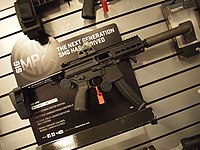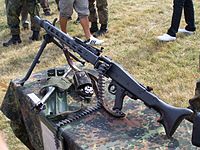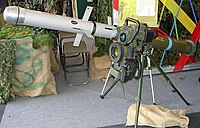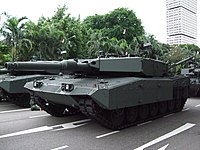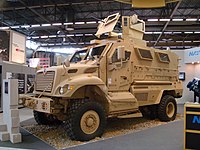Gassasinian Defence Force: Difference between revisions
No edit summary |
No edit summary |
||
| Line 24: | Line 24: | ||
}} | }} | ||
The Gassasinian Defence Force is the unified armed forces of [[Gassasinia]], being responsible for defending Gassasinia and its' people from external threats, along with supporting international peacekeeping efforts and humanitarian aid. The current Gassasinian Defence Force was formed in | The Gassasinian Defence Force is the unified armed forces of [[Gassasinia]], being responsible for defending Gassasinia and its' people from external threats, along with supporting international peacekeeping efforts and humanitarian aid. The current Gassasinian Defence Force was formed in 1980 from the previous Gassasinian Royal Armed Forces, and drew its' commanders, officers and soldiers from a diverse range of backgrounds to ensure that the Gassasinian Defence Force not just represented upper-class Sotirianism interests, but the interests of the people as a whole. | ||
Today the Gassasinian Defence Force is a well-equipped, well-organised and well-trained - albeit small force - relying on effective organisation and technological advantage over more numerous enemies. Officers have much more freedom to act on their own initiative, allowing for greater flexibility on the field compared to other Badawiyan armies who are often constrained out of fear of a military coup. It is well-equipped with a variety of modern armoured armoured fighting vehicles and aircraft developed in [[Euclea]] and [[Asteria Superior]] and often modified to meet Gassasinian needs. The Gassasinian Defence Force mainly consists of a professional force of volunteer soldiers, with conscription being abolished in 1985. | Today the Gassasinian Defence Force is a well-equipped, well-organised and well-trained - albeit small force - relying on effective organisation and technological advantage over more numerous enemies. Officers have much more freedom to act on their own initiative, allowing for greater flexibility on the field compared to other Badawiyan armies who are often constrained out of fear of a military coup. It is well-equipped with a variety of modern armoured armoured fighting vehicles and aircraft developed in [[Euclea]] and [[Asteria Superior]] and often modified to meet Gassasinian needs. The Gassasinian Defence Force mainly consists of a professional force of volunteer soldiers, with conscription being abolished in 1985. | ||
| Line 33: | Line 33: | ||
The Royal Gassasinian Armed Forces, the predecessor of the modern day Gassasinian Defence Force, was formed after 1949 from the Royal King's Badawiyan Rifles Regiment after the fall of Estmerish imperial rule in Gassasinia. Throughout its' early years, the Royal Gassasinian Armed Forces came to be known as corrupt and elitist - being primarily intended to protect the interests of the Sotirian elite - but also fiercely efficient and brutally repressive against those who threatened the Sotirian order. | The Royal Gassasinian Armed Forces, the predecessor of the modern day Gassasinian Defence Force, was formed after 1949 from the Royal King's Badawiyan Rifles Regiment after the fall of Estmerish imperial rule in Gassasinia. Throughout its' early years, the Royal Gassasinian Armed Forces came to be known as corrupt and elitist - being primarily intended to protect the interests of the Sotirian elite - but also fiercely efficient and brutally repressive against those who threatened the Sotirian order. | ||
In the lead-up to the | In the lead-up to the 1970's, various far-right paramilitary groups who were not officially past of the Gassasinian Royal Armed Forces but often attached to the Royal Gassasinian Police Service were formed, which often worked alongside the army and were responsible for a variety of atrocities before and during the Gassasinian Civil War. | ||
The Gassasinian Defence Force was formed in 1980 with King Yousef II as its' commander-in-chief. From the start, the Gassasinian Defence Force was designed to incorporate not just the Sotirian officers of the old army, but officers from a variety of ethno-religious and economic backgrounds, with selection being based on merit rather than status. While the branches retained their royal title, the Gassasinian Defence Force's name was chosen to represent the people of Gassasinia rather than the Sotirian monarch, and also to emphasise the defensive nature of the armed forces as a protective precaution of a peaceful nation. | |||
The Gassasinian Defence Force was formed in | |||
=Notable Units= | =Notable Units= | ||
==Special Air Service Unit== | |||
==Long Range Desert Group== | |||
==Parachute Regiment== | |||
=Equipment= | =Equipment= | ||
==Uniform== | ==Uniform== | ||
Revision as of 20:28, 29 August 2020
This article is incomplete because it is pending further input from participants, or it is a work-in-progress by one author. Please comment on this article's talk page to share your input, comments and questions. Note: To contribute to this article, you may need to seek help from the author(s) of this page. |
| Gassasinian Defence Force | |
|---|---|
| Service branches |
|
| Leadership | |
| Commander-in-Chief | King Yousef II bin Al-Hashim |
| Personnel | |
| Military age | 16 with parental consent, 18 without parental consent and for combat roles. |
| Available for military service | 1,707,694 males, age 15–49 (2019), 1,662,099 females, age 15–49 (2019) |
| Fit for military service | 2,416,480 males, age 15–49 (2019), 2,265,450 females, age 15–49 (2019) |
| Reaching military age annually | (2019) |
| Active personnel | 130,000 |
| Reserve personnel | 250,000 |
| Expenditure | |
| Budget | $9.76 billion |
| Percent of GDP | 2.5% |
| Industry | |
| Domestic suppliers |
|
| Foreign suppliers | |
The Gassasinian Defence Force is the unified armed forces of Gassasinia, being responsible for defending Gassasinia and its' people from external threats, along with supporting international peacekeeping efforts and humanitarian aid. The current Gassasinian Defence Force was formed in 1980 from the previous Gassasinian Royal Armed Forces, and drew its' commanders, officers and soldiers from a diverse range of backgrounds to ensure that the Gassasinian Defence Force not just represented upper-class Sotirianism interests, but the interests of the people as a whole.
Today the Gassasinian Defence Force is a well-equipped, well-organised and well-trained - albeit small force - relying on effective organisation and technological advantage over more numerous enemies. Officers have much more freedom to act on their own initiative, allowing for greater flexibility on the field compared to other Badawiyan armies who are often constrained out of fear of a military coup. It is well-equipped with a variety of modern armoured armoured fighting vehicles and aircraft developed in Euclea and Asteria Superior and often modified to meet Gassasinian needs. The Gassasinian Defence Force mainly consists of a professional force of volunteer soldiers, with conscription being abolished in 1985.
The Gassasinian Defence Force is known its' contributions to world-wide peacekeeping operations, having been present in some capacity in almost all Community of Nations-lead peacekeeping operations since 1990. The Gassasinian Defence Force is also important in ensuring internal security in Gassasinia, in particular helping the Royal Gassasinian Police to patrol the border with Tsabara.
History
The Royal Gassasinian Armed Forces, the predecessor of the modern day Gassasinian Defence Force, was formed after 1949 from the Royal King's Badawiyan Rifles Regiment after the fall of Estmerish imperial rule in Gassasinia. Throughout its' early years, the Royal Gassasinian Armed Forces came to be known as corrupt and elitist - being primarily intended to protect the interests of the Sotirian elite - but also fiercely efficient and brutally repressive against those who threatened the Sotirian order.
In the lead-up to the 1970's, various far-right paramilitary groups who were not officially past of the Gassasinian Royal Armed Forces but often attached to the Royal Gassasinian Police Service were formed, which often worked alongside the army and were responsible for a variety of atrocities before and during the Gassasinian Civil War.
The Gassasinian Defence Force was formed in 1980 with King Yousef II as its' commander-in-chief. From the start, the Gassasinian Defence Force was designed to incorporate not just the Sotirian officers of the old army, but officers from a variety of ethno-religious and economic backgrounds, with selection being based on merit rather than status. While the branches retained their royal title, the Gassasinian Defence Force's name was chosen to represent the people of Gassasinia rather than the Sotirian monarch, and also to emphasise the defensive nature of the armed forces as a protective precaution of a peaceful nation.
Notable Units
Special Air Service Unit
Long Range Desert Group
Parachute Regiment
Equipment
Uniform
Standard uniform for the Gassasinian Defence Force consists of Crye-designed Multicam fatigues, which are worn either with a field cap or boonie hat for work-purposes, or a beret coloured in correspondence with one's unit when on ceremonial and parade duties. When wearing the field-shirt for non-combat work duties, the left shoulder of the uniform bears the soldier's unit patch, whereas the right shoulder bears an IR patch of the national flag in tan and olive green colours. Additionally, on the left breast of the field-shirt is a name-tape reading the soldier's surname along with a tape on the right breast reading "GASSASINIA." Tankists and vehicle crews are issued jumpsuit coveralls and an olive green ![]() Hallandic tank helmet.
Hallandic tank helmet.
Often when wearing combats, instead of wearing a field shirt soldiers will wear a half-zip combat shirt. Along with this, for protection soldiers are issued Template:Country data Estmere Estmerish Mark 4 Osprey Body Armour and a Mark 7 helmet. Alternatively for less-intensive roles or other cases where full load isn't needed, troops are issued with a Multicam Estmerish-styled harness.
Small arms
| Name | Country | Image | Notes |
|---|---|---|---|
| Handguns | |||
| Glock 17 | Standard sidearm since 1995, replacing the Browning Hi Power. Limited local production by Zhayed Heavy Industries. | ||
| Browning Hi Power | Template:Country data Estmere | Standard sidearm until 1995, still sees very limited use. Common self-defence weapons for civilians with a firearms license. | |
| Submachine Guns and Carbines | |||
| MP5 | Standard submachine gun of the Gassasinian Defence Force, being phased out in favour of the new SIG MPX. Locally produced under license by Zhayed Heavy Industries until 2015, when it was decided that it would be replaced due to it being considered outdated. | ||
| MPX | Newly adopted standard submachine gun of Gassasinian Defence Force and Police. Adopted to phase out the MP5 due to greater modularity. Limited licensed production by Gassasinian Defence Systems. | ||
| MP7 | The MP7 is used in tandem with the MPX and MP5. The MP7 is well-liked thanks to its' PDW cartridge that can penetrate soft body armour. | ||
| Shotguns | |||
| Benelli M3 | Standard shotgun of the Gassasinian Defence Force and Police. Preferred thanks to its' dual semi-automatic or pump action mode. | ||
| Assault and Battle Rifles | |||
| Gassasinian Defence Systems K95 Rifle | Standard rifle of the Gassasinian Defence Force, replacing the M16A1 in 1995. Built upon the AR15 platform, featuring a variety of barrel lengths and the ability to fit a variety of modular attachments. | ||
| M16A2 | Standard rifle of the Gassasinian Defence Force of the Gassasinian Defence Force between 1965 and 1995, when it was phased out in favour of the K95 Rifle. Some M16A2 rifles are still in use with rear-echelon and reservist units. | ||
| HK416/HK417 | The HK416 assault rifle and its' battle rifle counterpart, the HK417, are both used by certain special forces and police units. | ||
| G3A3 | The G3 was phased out during the 1970s in favour of the M16A2 assault rifle. G3 rifles are kept in reserve and sometimes used to equip policemen. | ||
| Machine Guns | |||
| Zhayed Heavy Industries Ultimax 100 | The Ultimax 100 is an indigenously designed light machine gun dating back to the late 1970s. Although the design was finished in 1982, it only started production in 1987 due to political troubles. Phased out the FN MAG as the standard Squad Automatic Weapon. | ||
| FN MAG | Template:Country data Estmere | The FN MAG is the main general-purpose machine gun of the Gassasinian Defence Force. As of the 1990's, it has been mostly phased out in the Squad Automatic Weapon role but still sees significant use in other roles. | |
| MG3 | The MG3 is used in limited roles, specifically as a dedicated anti-infantry mounted machine gun for fortifications. | ||
| Sniper and Marksman Rifles | |||
Anti-Tank Weapons
| Name | Country | Image | Notes |
|---|---|---|---|
| Panzerfaust 3 | Standard AT weapon of infantry units. | ||
| MATADOR | |||
| Spike |
Armoured Fighting Vehicles
| Name | Country | Image | Quantity | Notes |
|---|---|---|---|---|
| Tanks | ||||
| Leopard-2A4/2A5/2A6 | 150/100/50 | Updated to "Leopard-2GA" standard using locally produced electronics, sensors and armour by Gassasinian Defence Industries and Hacohen Microsystems. | ||
| M60GA4 | 500 | Updated to the M60GA4 standard, which features a variety of modernisations and upgrades to the tank including the 120mm turret of an M1 Abrams and indigenous modular armour packages. | ||
| Infantry Fighting Vehicles | ||||
| LAV IV | 150 | Modified to use a suite of Gassasinian-designed electronics systems and sensors. | ||
| Schutzenpanzer Puma | 120 | Modified to use a suite of Gassasinian-designed electronics systems and sensors. | ||
| M1117 Armoured Security Vehicle | 180 | Modified to use a suite of Gassasinian-designed electronics systems and sensors. | ||
| Armoured Personnel Carriers | ||||
| GTK Boxer | 200 | Modified to use a suite of Gassasinian-designed electronics systems and sensors. | ||
| TPz Fuchs | 750 | Modified to utilise indigenously designed and produced sensors, electronics and modular armour systems. | ||
| Mine-Resistant Ambush Protected Vehicles | ||||
| MaxxPro MRAP | 300 | |||
Planes
| Name | Country | Image | Quantity | Notes |
|---|---|---|---|---|
| Combat Aircraft | ||||
| F-15 Eagle | Nuxica | 50 | Multi-role fighter-bomber, many are older production block models which have been upgraded by Hacohen Microsystems. | |
| F-16 Fighting Falcon | Nuxica | 190 | Multi-role fighter-bomber, many are older production block models which have been upgraded by Hacohen Microsystems. | |
| F-15 Strike Eagle | Nuxica | 20 | Strike fighter | |
| F2000 | 24, 24 on order | Multi-role stealth fighter, local modifications to utilise locally-produced armaments, electronic warfare suites and sensors produced by Hacohen Microsystems and Gassasinian Defence Systems. | ||
| AEW&C | ||||
| Reconnaissance | ||||
| Tanker | ||||
| Transport | ||||
| UAV | ||||
Helicopters
| Name | Country | Image | Quantity | Notes |
|---|---|---|---|---|
| Transport Helicopter | ||||
| Attack Helicopter | ||||
Ships
| Name | Country | Image | Quantity | Notes |
|---|---|---|---|---|
| Frigate | ||||
| Corvette | ||||
| Fast Attack Craft | ||||
| Support Ship | ||||



